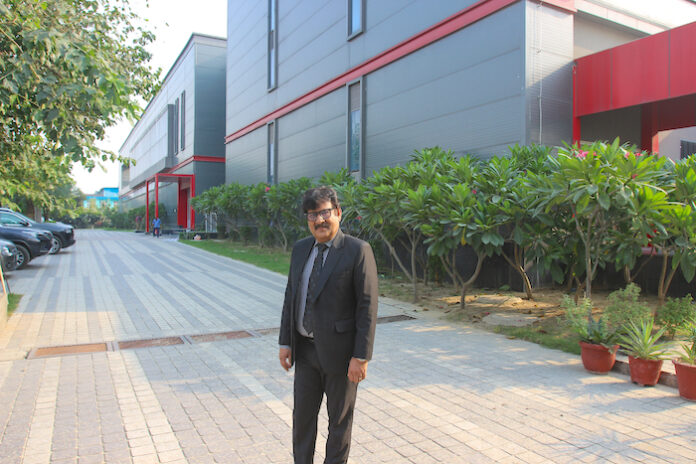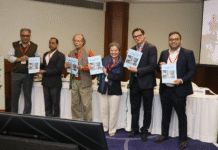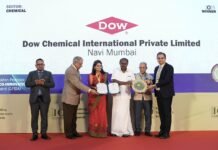In the industrial landscape of Greater Noida, Any Graphics has built a new plant that is three times larger than its previous one. For the company led by owner and founder Kuldip Goel, the new plant embodies a vision of innovative label and packaging production along with a design philosophy for a sustainable and human-centric work culture.
The plant continues and extends the business of highly decorated and enhanced labels and dome labels, where the company has been the industry pioneer. The company’s decade-old monocarton business has been brought into the new plant with room for growth, as well as the more recent rigid box expansion infrastructure for packaging electronics and other luxury products.
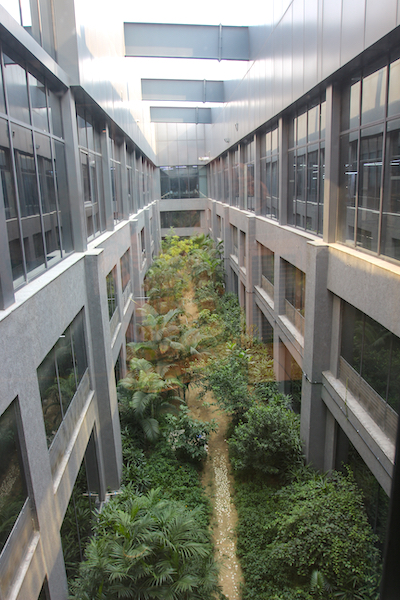
Goel shared the inspiration, thought process, and purpose behind this project – how the plant is a safehouse for its employees with high ambient air quality, every safety precaution, and sufficient workspace for each operation. Method, skilling, training, and safety are implicit in every step. The plant design and workflow work because of the established SOPs for each operation. Even raw material stack heights are limited for safety reasons. For Goel, efficiency comes from humans given the right opportunity and atmosphere in which they would love to work with pride in their output.
The plant has a built-up covered area of 2,50,000 square feet across three floors, situated on a 15,000-square-metre plot, making it three times larger than the company’s previous plant, which was also a marvelous purpose-built factory. “Our earlier facility had reached full capacity. Every aisle and corner was filled with material and boxes. With the addition of rigid box production, we needed much more space. So, my son and managing director, Naveen Goel, and I decided that this time, we’ll build something that can sustain our growth for years, at least three times bigger than before.”
A LEEDS certified future-ready ecosystem
From our visit to the massive new building, we understood something about the new plant’s concept and its ability to absorb workflows that incorporate modern technologies and machines with efficiency and sensitivity for the environment. An industry that talks about sustainability and climate change must walk the talk. While others talk about new industrial structures, the new Any Graphics plant is fully compliant and already LEEDS certified.
According to Goel, it is a future-ready ecosystem, ready for any plant audit – technical, social, or environmental. “Building a new factory every five or six years is not viable,” Goel explained. “It takes immense patience, design thinking, and careful layout planning to ensure smooth workflow and worker convenience. We wanted this facility to stand the test of time.”
The new plant integrates wide aisles for easy access and evacuation, ample natural ventilation, and multiple fire exits. The entries and wide aisles also work for the movement and installation of new machinery. These design choices ensure not just regulatory compliance but concern for the people who work there. “A lost or damaged life doesn’t just affect one person, it impacts an entire family,” he reflects, pointing to a human approach to industrial design – to humans at the centre of any ecosystem.

The glass-walled spaces for design, digital prepress, and prototyping are close to the numerous conference rooms for client meetings on the first floor. The narrow web label presses, the screen printing plant, the offset presses, and converting equipment for cartons, and the hard box making machines are on the ground floor. The entire complement of industrial assets to produce labels and packaging that stand out on the shelf is placed according to the workflow in controlled ambient atmosphere and lighting conditions. The monocarton section contains the two Heidelberg 7-color coater UV presses – including the most recent, a CX104 press and the Bobst diecutters and folder gluers.
From lean management principles to worker movement and the work-in-progress material flow, nothing was left to chance. The factory’s workflow was digitally mapped for six months by Goel and his son, ensuring seamless production movement and zero material wastage. The raw material store is in the basement with an industrial lift bringing it to the multiple pressrooms for each process – labels, dome labels, cartons, and hard boxes.
The entry and reception spaces on the first floor, which also house the executive offices, are part museum, and part award gallery. Respect for the history of print and the more recent history of the numerous awards won by the company for its craft, industry, and imagination are displayed. The interior of the entire factory consists mainly of wide spans without walls, while the partitions and enclosures in the office spaces and meeting rooms for client consultation are made of glass.
The enclosed forest is a carbon sink
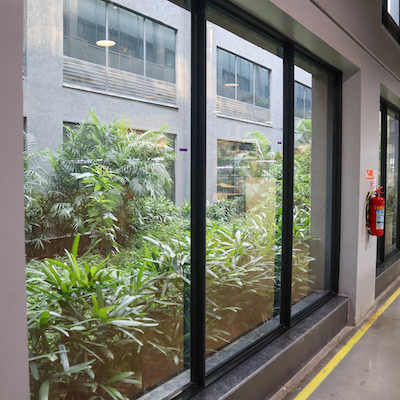
It’s a transparent place that gives out to a green space for get-togethers, and in the center of the factory lies a lush green enclosed courtyard. “A dense indoor forest,” as Goel says. Open to the sky, a carbon sink meant to supply naturally cleaned air to the interior spaces. The entire boundary is thematically surrounded by trees – many of these preserved from the original landscape.
“From the outside, you can’t tell if it’s a factory, a mall, or a studio,” Goel commented. “But once you enter, you’ll see that everything, from layout to lighting, is designed creatively and transparently.”
For Goel, the connection between art and production is deeply personal. “I began my career as a designer and screen printer. Creation and design are in my blood,” he says. It is this artistic touch that makes Any Graphics not just a printing company but a creative house. The next generation is already there and leading the way, “The future is up to them,” he says.
For himself, the road to success has been one of challenges, experience, and the help of good people. Its meaning is not only profitability or expansion, but in the happiness, safety, and creative engagement of his team. According to him, the new plant is a symbol of sustainability, aesthetics, and human compassion. “It is a space where technology meets nature, and where design meets purpose. Label and packaging design and production are creative. It’s not just business, it’s art,” concludes Goel.



